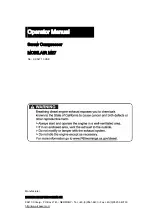
244 of 282
M-SV-001-EN Rev. G
5.2.1 Compressor Fault Troubleshooting
When troubleshooting a compressor fault, detailed analysis of this data should be made (in
conjunction with a Yenta compressor recording file, if possible) to determine the specific fault and
determine the root cause of fault occurrence.
Downloading fault and event logs every time a compressor is visited is useful for documenting
compressor operational history.
Fault and event history can be extracted from the compressor memory in the
SMT Logged Event and
Fault Viewer
tool. See the latest Service Monitoring Tools User Manual for user instructions.
Active compressor fault and alarm messages can be viewed in the
SMT Active Alarm/Fault Viewer
tool.
See the latest Service Monitoring Tools User Manual for user instructions.
Compressor Alarm and Fault settings can be found in the
Configure Alarms/Faults
menu option of the
Active Alarm/Fault Viewer tool.
The
Compressor Data Recording and Playback
tool provides a method of reviewing operational
conditions without a connection to the compressor. It also creates a file to electronically transmit for
peer review. See the latest Service Monitoring Tools User Manual for use instructions.
The following principle is applied when having both a fault and/or an alarm limit as triggers. Refer
to "Figure 5-1 Fault Trigger Methods" for explanations regarding faults and alarms and the trigger
method terminology is used: Instant fault triggering (INS), Ascending Fault Triggering (AFT),
Descending Fault Triggering (DFT) and Range Fault Triggering (RFT).
Figure 5-1 Fault Trigger Methods
Fault Reset:
A fault that does not require a power cycle to clear (non-critical) can be reset in the
following manner: Interlock must be closed, set the Demand to 0 and afterwards to a value greater
than 0. Now the fault is reset and the compressor is ready to run. The assumption is that the cause of
the fault has been rectified.
Fault Limit
Alarm Limit
Alarm Limit
Fault Limit
Alarm
Triggered
Fault
Triggered
DFT - Descending Fault Triggering
AFT - Ascending Fault Triggering
RFT - Range Fault Triggering
Upper
Range
Limit
Lower
Range
Limit
Содержание TGH285
Страница 14: ...14 of 282 M SV 001 EN Rev G THIS PAGE INTENTIONALLY LEFT BLANK ...
Страница 30: ...30 of 282 M SV 001 EN Rev G THIS PAGE INTENTIONALLY LEFT BLANK ...
Страница 38: ...38 of 282 M SV 001 EN Rev G THIS PAGE INTENTIONALLY LEFT BLANK ...
Страница 40: ...40 of 282 M SV 001 EN Rev G THIS PAGE INTENTIONALLY LEFT BLANK ...
Страница 46: ...46 of 282 M SV 001 EN Rev G THIS PAGE INTENTIONALLY LEFT BLANK ...
Страница 50: ...50 of 282 M SV 001 EN Rev G THIS PAGE INTENTIONALLY LEFT BLANK ...
Страница 238: ...238 of 282 M SV 001 EN Rev G THIS PAGE INTENTIONALLY LEFT BLANK ...
Страница 240: ...240 of 282 M SV 001 EN Rev G THIS PAGE INTENTIONALLY LEFT BLANK ...
Страница 260: ...260 of 282 M SV 001 EN Rev G THIS PAGE INTENTIONALLY LEFT BLANK ...
Страница 262: ...262 of 282 M SV 001 EN Rev G THIS PAGE INTENTIONALLY LEFT BLANK ...
Страница 268: ...268 of 282 M SV 001 EN Rev G THIS PAGE INTENTIONALLY LEFT BLANK ...
Страница 276: ...276 of 282 M SV 001 EN Rev G THIS PAGE INTENTIONALLY LEFT BLANK ...
Страница 280: ...280 of 282 M SV 001 EN Rev G THIS PAGE INTENTIONALLY LEFT BLANK ...
















































